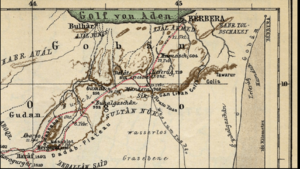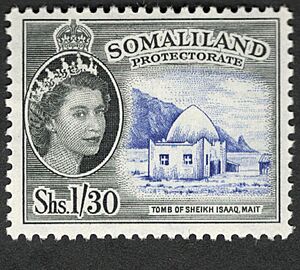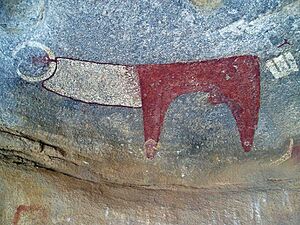History of Somaliland facts for kids
The history of Somaliland tells the story of a country in the eastern Horn of Africa. It's next to the Gulf of Aden and the main African landmass. People have lived here for tens of thousands of years. Its history includes ancient civilizations like the Land of Punt, the Ottoman Turks, and later, influences from Europe and the Middle East.
Contents
Ancient Times
Somaliland has been home to people for a very long time, even before the Stone Age. During the Stone Age, two important cultures, Doian and Hargeisan, thrived here. The oldest burial sites in the Horn of Africa are in Somalia, dating back to 4000 BC. Tools found at the Jalelo site in the north also show how ancient people lived.
Experts believe the first people speaking Afro-Asiatic languages came to this area during the Neolithic period. They might have come from the Nile Valley or the Near East. Other experts think these languages developed right here in the Horn of Africa.
The Laas Geel complex, near Hargeisa, is about 5,000 years old. It has amazing rock art showing wild animals and decorated cows. More cave paintings are found in the northern Dhambalin region. One painting there shows one of the earliest pictures of a hunter riding a horse. These paintings are in a special Ethiopian-Arabian style and are from 1000 to 3000 BCE. Also, between Las Khorey and El Ayo, there's Karinhegane. This site has many cave paintings of real and mythical animals. Each painting has a message below it, and they are thought to be around 2,500 years old.
The Land of Punt
Many experts believe the ancient Land of Punt was in the Horn of Africa. This area includes parts of today's Somaliland, Somalia, Djibouti, and Eritrea. This idea comes from the goods found in Punt, as shown in the murals of Queen Hatshepsut in Egypt. These goods, like gold, myrrh, and ebony, were common in this part of Africa. The murals also show animals like giraffes, baboons, hippos, and leopards, which are African animals.
The people of Punt traded myrrh, spices, gold, ebony, cattle, ivory, and frankincense. The Ancient Egyptians really wanted these items. An Egyptian journey to Punt, sent by Queen Hatshepsut, is shown on temple walls. This happened during the time of Puntite King Parahu and Queen Ati.
-
Sculptures found in Berbera, Somaliland. They show a cobra symbol (uraeus) on the headdress.
Early Trade Routes
In ancient times, important cities like Malao (Berbera) and Mundus ([Xiis/Heis]) grew wealthy. They were big players in the spice trade, selling myrrh and frankincense to the Romans and Egyptians. Somaliland and Puntland became known for spices, especially cinnamon. The book Periplus of the Erythraean Sea tells us that the northern regions of Somaliland and Puntland were independent. They even competed with the Aksum kingdom for trade.
First Islamic States
When Islam arrived in the 7th century, new Islamic states began to form. These included the sultanates of Shewa, Ifat, and Adal. Adal was centered in Dakkar and later Harar, with Zeila as its main port.
These regions later came under the control of the Ethiopian Empire. For about two centuries, there were many wars between Ifat and Ethiopia. In the early 1400s, a revolt by Ifat was stopped. Its ruler, Sa'ad ad-Din II, was captured and killed in Zeila. After this war, a song was made to celebrate the Ethiopian victory. This song contains the first written mention of the word "Somali."

Around 1527, a strong leader named Imam Ahmad ibn Ibrihim al-Ghazi (also known as Gurey or Gragn, meaning "left-handed") led Adal in a revolt. They invaded Ethiopia with help from the Ottoman Empire. They used harsh tactics, destroying churches and manuscripts. Adal's use of firearms, which were rare in Ethiopia, helped them conquer more than half of Ethiopia.
Ethiopia was saved by the arrival of a Portuguese army led by Cristovão da Gama. The Portuguese had been in the area before. They responded to Ethiopia's call for help and sent soldiers. Even though the Portuguese first lost a battle and their commander was killed, a combined Portuguese-Ethiopian force later defeated the Somali-Ottoman army in 1543. Imam al-Ghazi was killed, and the war ended.
Ahmed al-Ghazi's widow married Nur ibn Mujahid, who promised to get revenge. He continued fighting Ethiopia until he killed the Ethiopian Emperor. Emir Nur died in 1567. The Sultanate of Adal then broke apart into many smaller, independent states, often led by Somali chiefs.
New Kingdoms Rise
In the early modern period, new states grew in Somaliland after the Adal Sultanate. By the 1600s, the Somali lands were divided into many clan states, including the Isaaq. These new states continued to build castles and trade by sea, just like earlier Somali empires.
One of these was the Isaaq Sultanate, led by the Guled Dynasty. This sultanate was formed in 1750. It ruled parts of the Horn of Africa in the 18th and 19th centuries. It covered the lands of the Isaaq clan in modern-day Somaliland and Ethiopia. The first sultan, Sultan Guled Abdi, started the Guled dynasty.
Stories say that before the Guled dynasty, the Isaaq clan was ruled by the Tolje'lo branch for centuries. The last Tolje'lo ruler, Boqor Harun, was overthrown by a group of Isaaq clans.
The modern Guled Dynasty began in the mid-18th century. Sultan Guled was from the Eidagale line of the Garhajis clan. He became sultan after the Battle of Lafaruug in 1749. In this battle, his father, Chief Abdi Chief Eisa, led the Isaaq to victory against the Absame tribes. The Isaaq chiefs saw his leadership and wanted to make his father sultan. But his father refused and gave the title to his young son, Guled. Guled became the first Sultan of the Isaaq clan in July 1750 and ruled until he died in 1808.
After Sultan Guled died, his 12 sons argued over who would be the next ruler. His eldest son, Roble Guled, was supposed to be crowned. But his brother Du'ale tricked him, causing Roble to lose his chance. Another brother, Jama, refused the crown and suggested their half-brother Farah. So, Farah was crowned as the next sultan.
Early European Encounters
The city of Berbera was a very important port for the Sultanate. Caravans would pass through Hargeisa, and the Sultan would collect taxes from traders going to the coast. In the mid-1840s, there was a big fight between two groups of the Habr Awal clan over who would control Berbera. Sultan Farah brought them together to swear peace on a holy item from the tomb of Aw Barkhadle.
When European ships started coming to the Gulf of Aden, Somalis and Europeans met again. In 1825, a British ship called the Mary Anne tried to dock in Berbera. It was attacked, and many crew members were killed. The Royal Navy blocked the port in response. Some stories say they even bombed the city. In 1827, the British offered to lift the blockade if the Isaaq paid for the damage. This led to the Battle of Berbera 1827. After the Isaaq lost, they had to pay 15,000 Spanish dollars.
In the 1820s, Sultan Farah Guled of the Isaaq Sultanate wrote a letter to Sultan bin Saqr Al Qasimi of Ras Al Khaimah. He asked for military help against the British. But Sultan Saqr could not send aid. The Qasimi people were very active in trade and sometimes attacked ships in the Gulf of Aden. They had strong trade ties with the Somalis and often visited the ports of Berbera and Zeila.
British Somaliland

The British Somaliland protectorate was first managed by British India. Its main goal was to help Britain control the important Bab-el-Mandeb strait. This strait protected the Suez Canal and British shipping routes through the Red Sea and the Gulf of Aden.
People in the protectorate became unhappy with British rule. They felt Britain was making too much money from their trade and farming. In 1899, a religious scholar named Mohammed Abdullah Hassan started a holy war. Hassan built an army united by Islam and created the Dervish State. They fought against Ethiopian, British, and Italian forces. At first, they fought in open battles, but later they used surprise attacks (guerrilla tactics).
The British launched four early expeditions against him. The last one in 1904 ended without a clear winner. A peace agreement was made in 1905 and lasted for three years. British forces pulled back to the coast in 1909. In 1912, they formed a camel police force, but the Dervishes destroyed it in 1914.
During the First World War, the new Ethiopian Emperor Iyasu V helped the Dervishes. He sent them weapons and money. Germany also sent a mechanic, Emil Kirsch, to help the Dervish forces with weapons. Germany encouraged Ethiopia to help the Dervishes. The Ottoman Empire sent a letter to Hassan in 1917, promising support and calling him "Emir of the Somali nation." At his strongest, Hassan led 6,000 troops. By November 1918, the British were spending all their money trying to stop the Dervishes. The Dervish state finally fell in February 1920 after a British campaign that included bombing from the air.
Even after this, small uprisings happened for decades. However, they were much smaller because the British improved the area's infrastructure and had a more helpful approach.
During World War II, Italy took over the protectorate in August 1940. But the British took it back in the summer of 1941. Some Italian guerrilla fighting continued until 1942. Taking over British Somaliland was Italy's only victory in WWII without German help.
-
A women's market in Hargeisa, British Somaliland.
-
Airplanes bombing Dervish forts in Taleh.
-
Map showing the invasion route of the Italian conquest of British Somaliland in August 1940.
-
Buralleh (Buralli) Robleh, a police officer, and General Gordon, Governor of British Somaliland, in Zeila (1921).
Becoming Independent
In 1947, the total money spent on running the British Somaliland protectorate was only £213,139.
In May 1960, the British Government said it was ready to give independence to the Somaliland protectorate. The local council in British Somaliland voted in April 1960 to ask for independence. The councils of both territories agreed to this plan.
In April 1960, leaders from both territories met in Mogadishu. They agreed to form one country. An elected president would be the head of state. A prime minister would have full power and answer to an elected National Assembly with 123 members from both areas.
On June 26, 1960, the British Somaliland protectorate became independent as the State of Somaliland. Five days later, on July 1, 1960, it joined with the Trust Territory of Somalia to form the Somali Republic (Somalia).
The legislature chose Hagi Bashir Ismail Yousuf as the first President of the Somali National Assembly. On the same day, Aden Abdullah Osman Daar became President of the Somali Republic.
-
Agreements between the United Kingdom and the State of Somaliland for its independence.
-
The Somaliland Protectorate Constitutional Conference in London, May 1960. Here, it was decided that June 26 would be Independence Day.
Seeking Independence Again
At a big meeting in Burao on May 18, the Somali National Movement (SNM) and elders from the main clans declared that the Republic of Somaliland was restored. This meant they wanted to be independent again, in the same area as the old British Somaliland protectorate. They formed their own government. This happened after the central government in Somalia collapsed during the Somali Civil War. However, no country or international group has officially recognized Somaliland's independence.
See also
 In Spanish: Historia de Somalilandia para niños
In Spanish: Historia de Somalilandia para niños



















